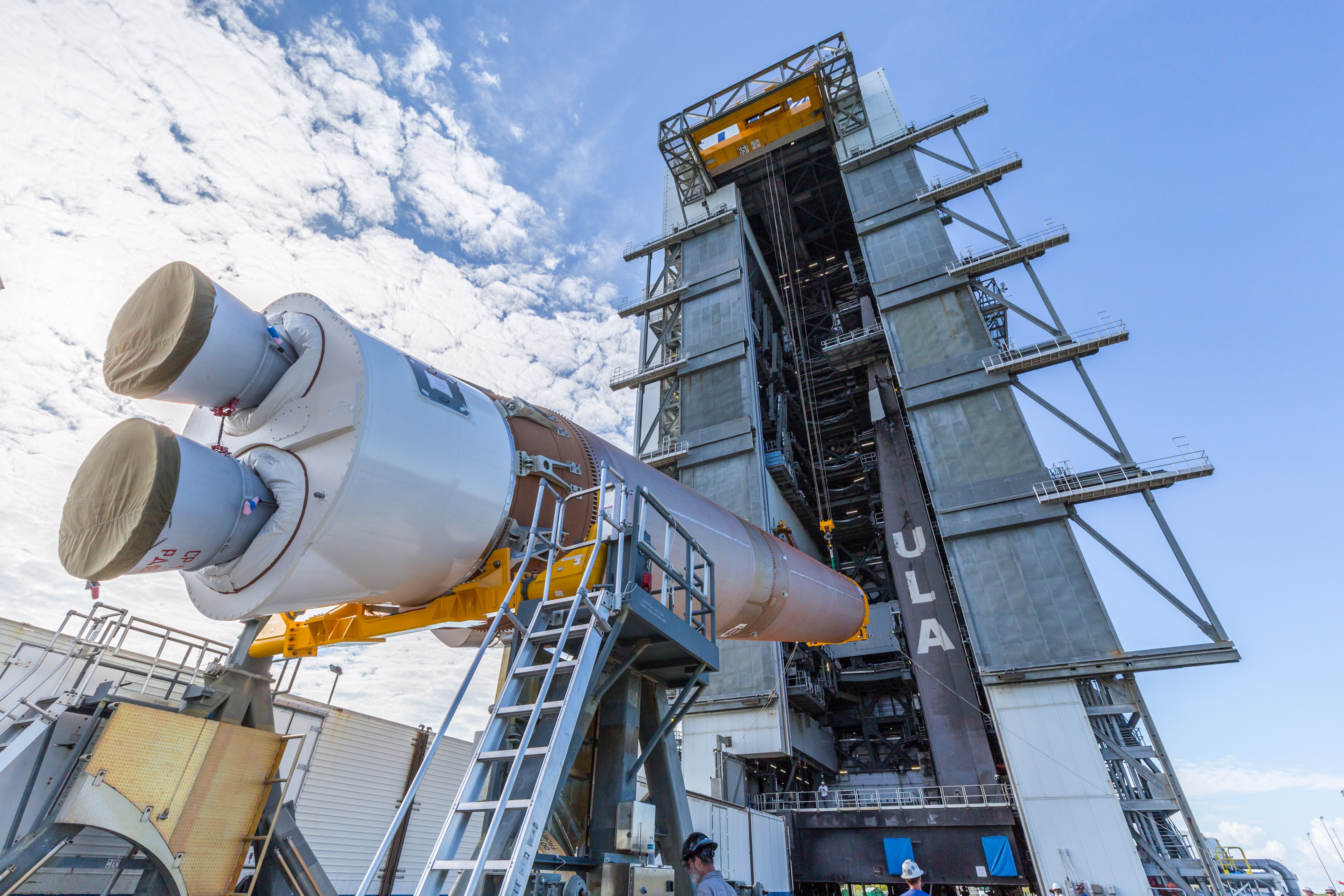
United Launch Alliance (ULA) uses heavy-duty cranes, teamwork and a lot of coordination to assemble our massive rockets before they head into space. That art of rocket stacking is both time-tested and an obligation to some passengers who require vertical integration of their payloads.
This week, engineers and technicians at Cape Canaveral Space Force Station, Florida, completed the initial buildup of the Atlas V 501 rocket that will launch prototypes of the Project Kuiper broadband system for Amazon.
The satellites will add real-world data from space to results from Amazon's extensive lab testing, fieldwork, and simulation. This Protoflight mission also helps Amazon finalize design, deployment and operational plans ahead of a full-scale deployment beginning in 2024.
Preparations for this first launch began Sept. 16 with the Launch Vehicle on Stand (LVOS) milestone.
Before sunrise, the move crew arrived at the Advanced Spaceflight Operations Center (ASOC) to configure the Atlas V first stage for its delivery to the Vertical Integration Facility (VIF), located about four miles up the road.
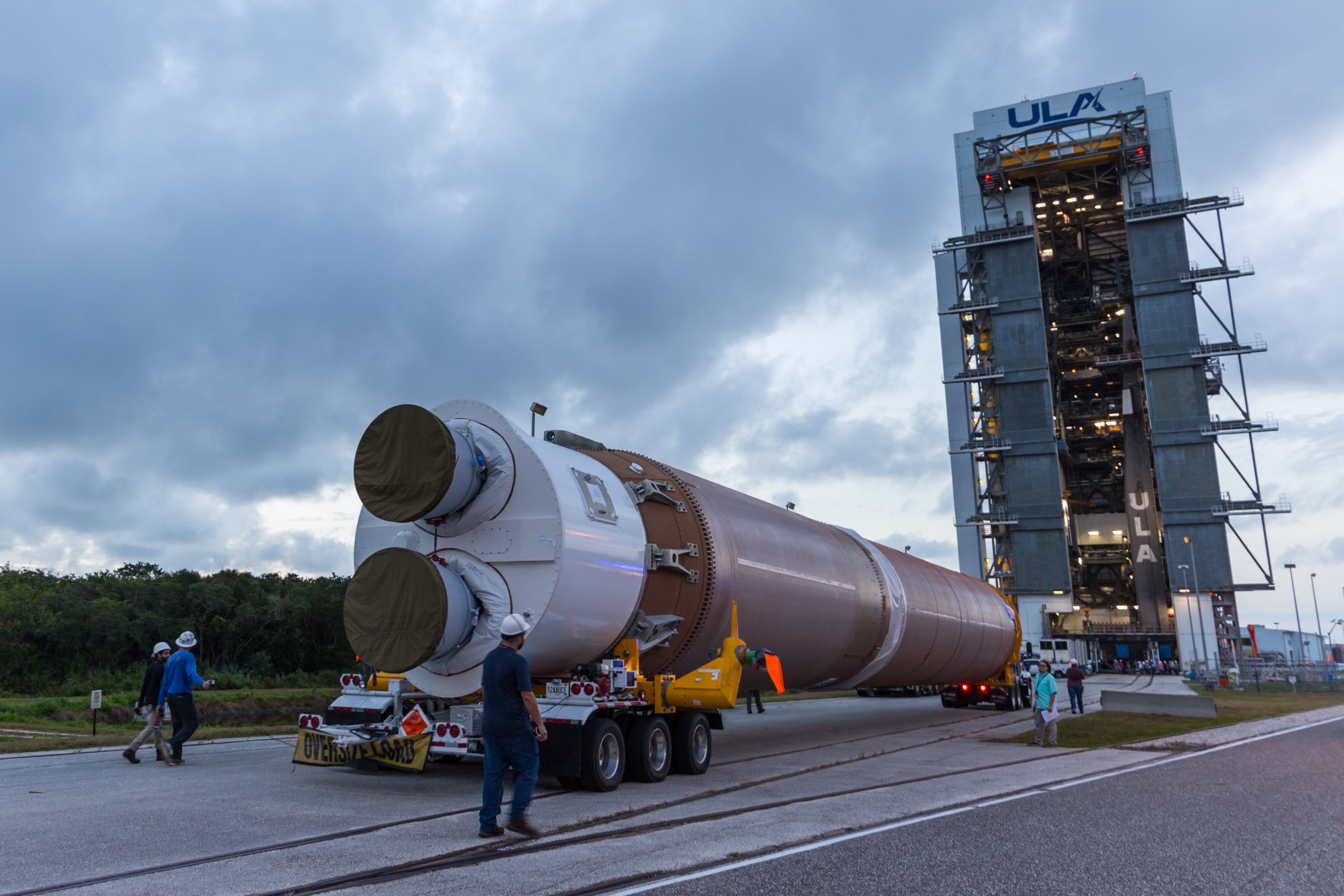
The 106.5-foot-long (32.5m), 12.5-foot-diameter (3.8m) stage is pulled by a semi-truck while its hefty engine section in the aft rests on a dolly with steerable axles for maneuvering the rocket in challenging turns during transports.
The truck's air-ride system was readied, the dolly was powered up and the team received a final briefing before departure, explained Alex Polimeni, the ULA launch operations mechanical engineer in charge of the day's move.
"The booster transport signals the very beginning of a launch campaign at Cape Canaveral, and it is humbling to be entrusted with the responsibility and safety of a large part of the launch vehicle for a critical mission," Polimeni said.
Emerging from the ASOC bay, Atlas V made its pre-dawn traverse at a top speed never exceeding 25 mph (40 kmph).
Passing by the VIF and entering Space Launch Complex (SLC)-41, the rocket made the onerous U-turn and drove to the north apron of the VIF, parking at precise marks within the overhead crane's envelope for the hoisting operations to come.
The hoist crew, led by ULA engineer Kevin Stevenson, then took over. He has worked in the aerospace industry since 1987, a career that includes the space shuttle, Delta II, Atlas V and Vulcan.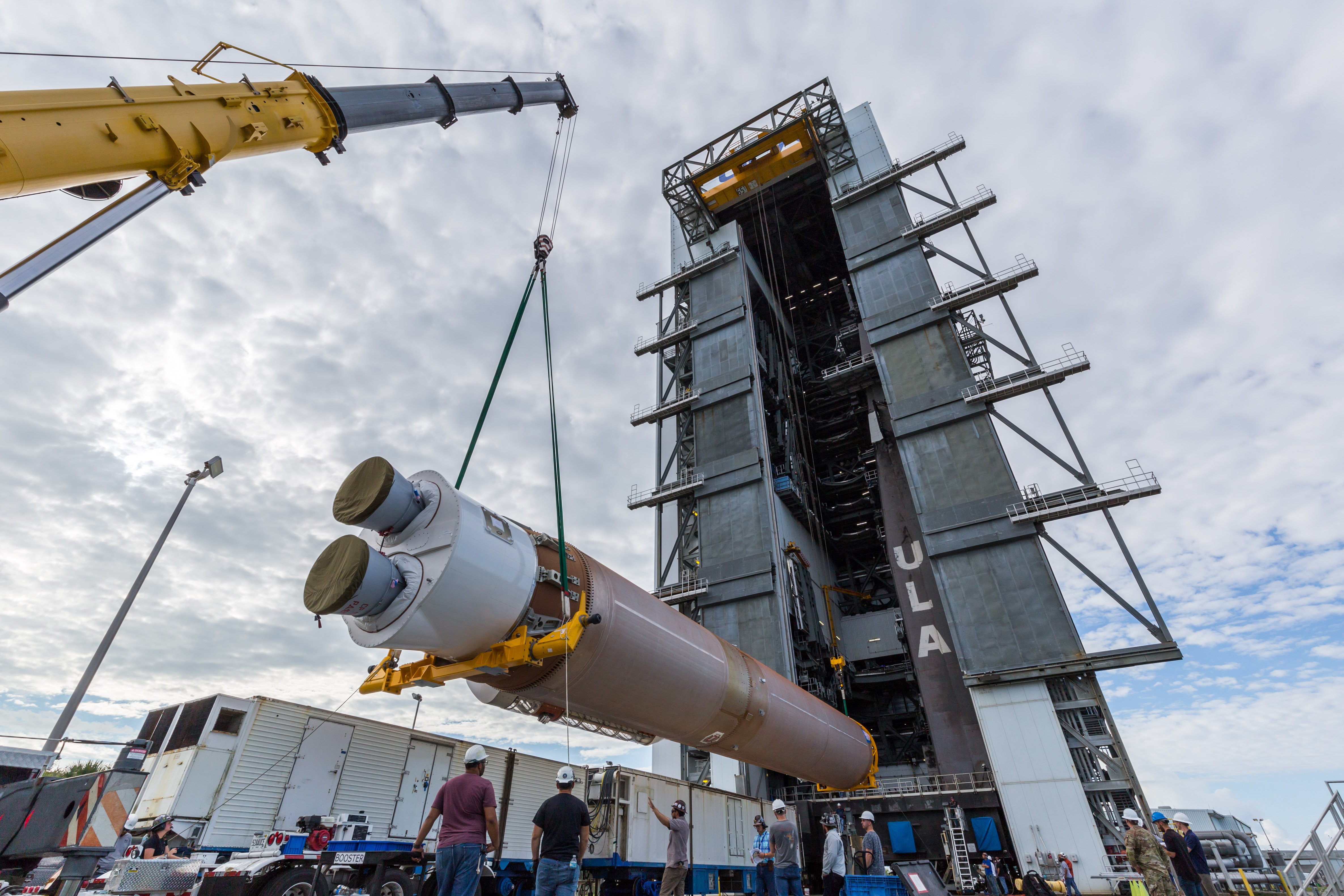
What's it like to be the person in charge of hoisting a giant rocket? "Hectic, challenging and fun. Keeping an eye on all the preps leading up to the task is very important for a smooth and successful operation. Making sure things go as intended while performing the ops keeps you busy," Stevenson said.
"But it is never routine. New challenges seem to find a way to creep into the best made plans."
The LVOS team of approximately 25 personnel starts its work by attaching the VIF crane to the forward lift fixture bolted to the front of the Atlas and a mobile crane used to lift the rocket's aft end by connecting it onto a perpendicular beam running underneath the booster.
After raising the horizontal rocket a few inches to disengage the semi-truck, the driver then shimmied it out of the tight confines between the booster and the Mobile Launch Platform (MLP).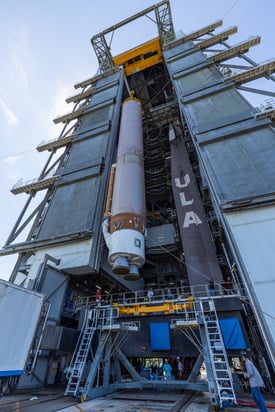 That allowed the cranes to fully raise the rocket several feet higher into the air while a special mechanical structure, called the breakover fixture, was moved along rail tracks to the desired position for the bright-yellow aft beam to be situated in its receiving sockets.
That allowed the cranes to fully raise the rocket several feet higher into the air while a special mechanical structure, called the breakover fixture, was moved along rail tracks to the desired position for the bright-yellow aft beam to be situated in its receiving sockets.
The breakover fixture is the device that enables the Atlas V to be rotated from horizontal to vertical. Once the mobile crane is detached, only the VIF crane in the front is left to do the lifting.
The crane slowly began to draw upwards as the breakover fixture inched forward toward the building, with spotters watching both on the ground and in the VIF as the translation proceeded. The aft beam glacially rotated in the sockets as the bronze booster steadily moved 90 degrees to stand upright.
Once pointed skyward, the aft beam was unfastened and the rocket was ready to be hoisted through the VIF doorway and positioned on the MLP.
Getting the booster on the MLP involved lining up supports on the rocket with the three launch mounts that protrude from the platform. They will contain the release mechanisms that fire at liftoff for the Atlas V to depart the launch pad with its main engine at full throttle.
Following a day of preparations and removal of the forward lift fixture from the rocket, the Centaur upper stage attachment came on Sept. 19 to complete the rocket's main assembly, minus only the satellite payload.
Michael DeArce, a ULA engineer since 2016 and three-year veteran working pneumatic, propulsion and mechanical operations on Centaur, oversaw getting the upper stage lifted and bolted into place atop the first stage.
Centaur came to the VIF in a pre-assembled structure known as the Offsite Vertical Integration (OVI) stack, which consists of the interstage adapter, the Centaur stage and the lower half of the payload fairing, called the base module. The OVI is put together in a test cell at the Delta Operations Center (DOC) and then moved to the VIF when the first stage is ready to receive.
"To build an OVI stack, there are six hoisting operations that need to be performed. Each lift has its own weather restrictions, and since Florida weather can be unpredictable, this can cause schedule delays when building the rocket outside at the VIF. OVI processing allows us to do all of these lifting operations inside the DOC while sheltered from the weather to reduce any delays," DeArce said.
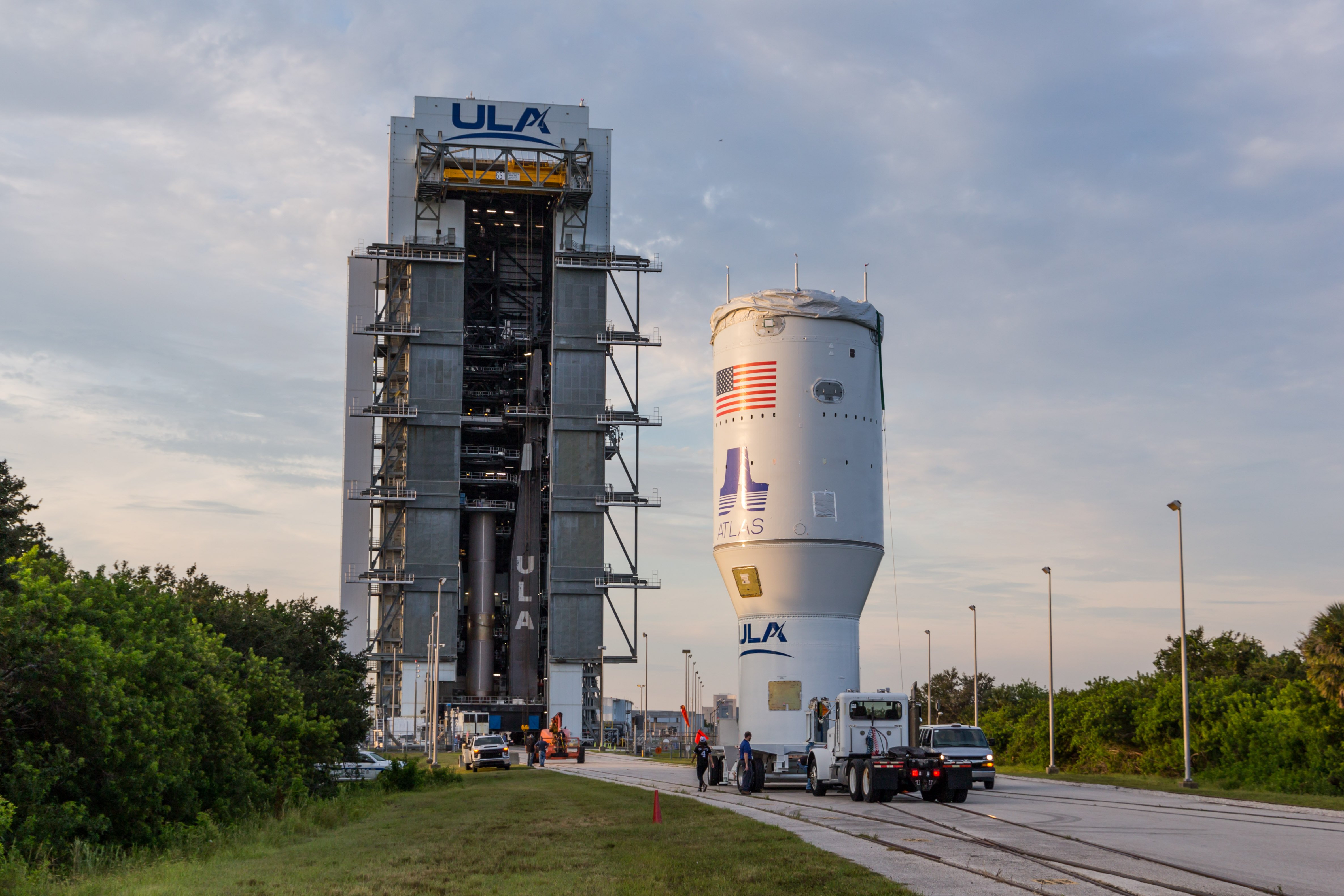
Leaving the DOC at dawn, a semi-truck pulled the OVI stack across Cape Canaveral at a top speed of 10 mph (16 kmph).
"A completed OVI stack is approximately 60 feet (18 m) tall and top heavy. This puts the center of gravity well above the ground which requires us to transport very slowly and to have strict wind restrictions when transporting to the VIF," DeArce said.
Once positioned at the VIF, technicians used a cherry-picker to reach the top of the OVI to attach the crane while other workers removed the bolts holding the stack steady on the transport trailer.
Then it was time to lift.
"There is a lot of coordination required during the hoisting operation between multiple teams doing different task. When leading this operation, you are responsible for the teams to prepare for the hosting operation, securing the OVI stack from the transport and readying all of our pneumatic systems before we are ready to mate," DeArce said.
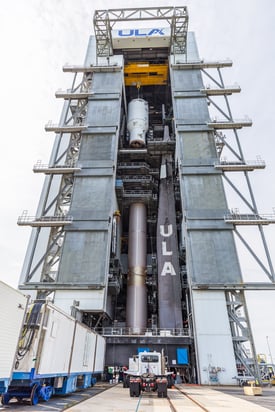
After going up and into the building, the crane operator slowly lowered the OVI onto the top of the first stage where technicians were ready to install permanent bolts all the way around the interface to join the booster and the interstage adapter, which do not separate during launch.
"It is pretty awesome to be responsible for hoisting the OVI stack, you spend all of this time working on building up a third of the rocket and then in just one lift you get to see all of that work get placed on top of the booster, ready for the next round of testing before it is ready for launch."
Power up and system checkouts of the rocket are planned over the next several days to ensure all flight hardware is functioning as expected. That will clear the way for the encapsulated payload to be delivered to the VIF for its hoisting atop the rocket to complete the fully assembled, 196-foot-tall (59.7m) Atlas V 501 launch vehicle.
This will be the 99th flight of the Atlas V program and the 82nd to originate from the Cape.
Learn more about the Project Kuiper Protoflight launch
See more photos in our Flickr album

 Back To Blog List
Back To Blog List



